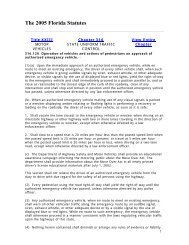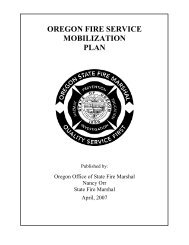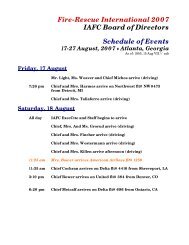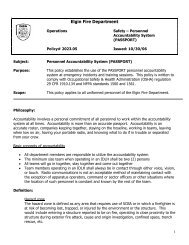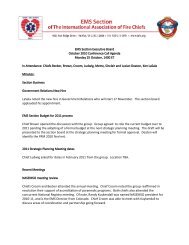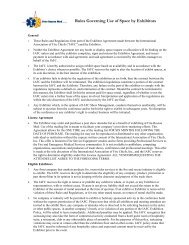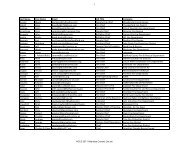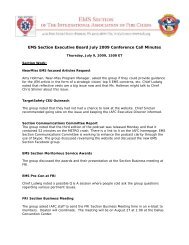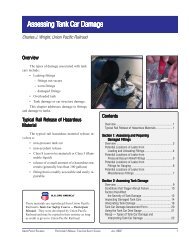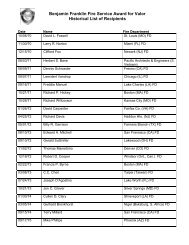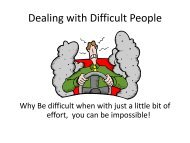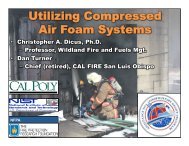Effects of Sleep Deprivation on Fire Fighters and EMS ... - NAEMT
Effects of Sleep Deprivation on Fire Fighters and EMS ... - NAEMT
Effects of Sleep Deprivation on Fire Fighters and EMS ... - NAEMT
You also want an ePaper? Increase the reach of your titles
YUMPU automatically turns print PDFs into web optimized ePapers that Google loves.
<str<strong>on</strong>g>Effects</str<strong>on</strong>g> <str<strong>on</strong>g>of</str<strong>on</strong>g> <str<strong>on</strong>g>Sleep</str<strong>on</strong>g> <str<strong>on</strong>g>Deprivati<strong>on</strong></str<strong>on</strong>g> <strong>on</strong> <strong>Fire</strong> <strong>Fighters</strong> <strong>and</strong> <strong>EMS</strong> Resp<strong>on</strong>ders<br />
Naps as short as 20 minutes can be effective in restoring mental abilities, <strong>and</strong> naps <str<strong>on</strong>g>of</str<strong>on</strong>g> two hour<br />
during l<strong>on</strong>g work shifts can be highly restorative. Based <strong>on</strong> the disproporti<strong>on</strong>ate recovery<br />
potential <str<strong>on</strong>g>of</str<strong>on</strong>g> relatively short (less than 45 minutes) periods, these “power naps” have been<br />
investigated as a strategy to attenuate performance deficits during <strong>and</strong> following periods <str<strong>on</strong>g>of</str<strong>on</strong>g><br />
sleep deprivati<strong>on</strong> (Gillberg, Kecklund & Axelss<strong>on</strong>, 1996). Studies by NASA showed that planned<br />
naps by pilots <strong>on</strong> l<strong>on</strong>g-haul flights improved alertness when l<strong>and</strong>ing.<br />
For most types <str<strong>on</strong>g>of</str<strong>on</strong>g> night work, nap breaks are generally not an opti<strong>on</strong>, despite their potential for<br />
suppressing sleepiness. However, some industrial organizati<strong>on</strong>s have begun promoting napping<br />
as a means to improve c<strong>on</strong>diti<strong>on</strong>s, work performance <strong>and</strong> safety (Takeyama, Kubo & Itani, 2005).<br />
Stanford researchers (Smith-Coggins et al., 2006) examined emergency room doctors <strong>and</strong> found<br />
that short naps during a 12 hour night shift resulted in better performance <strong>on</strong> written memory tests,<br />
a simulated car drive <strong>and</strong> simulated intravenous line inserti<strong>on</strong>. As a result, their hospital instituted<br />
a sancti<strong>on</strong>ed napping program. Suggesti<strong>on</strong>s for emergency room staffing patterns have included<br />
recommendati<strong>on</strong>s to allow strategic napping prior to work <strong>and</strong> following 12 hour shifts before<br />
driving home (J<str<strong>on</strong>g>of</str<strong>on</strong>g>fe, 2006).<br />
Studies performed am<strong>on</strong>g flight crews by NASA <strong>and</strong> the Federal Aer<strong>on</strong>autics Administrati<strong>on</strong> also<br />
revealed informati<strong>on</strong> about ‘planned naps.’ They found that naps could be scheduled in anticipati<strong>on</strong><br />
<str<strong>on</strong>g>of</str<strong>on</strong>g> fatigue, <strong>and</strong> they did not need to wait until an individual was so fatigued that involuntary napping<br />
occurred. Most people could fall asleep during planned naps in a reas<strong>on</strong>able time (i.e., five to ten<br />
minutes) (Rosekind et al., 1994).<br />
A potential adverse effect <str<strong>on</strong>g>of</str<strong>on</strong>g> napping is the grogginess or sleep inertial experienced up<strong>on</strong> awakening<br />
(see page 2). Naps l<strong>on</strong>ger than 45 minutes can result in awakening during the deeper stages <str<strong>on</strong>g>of</str<strong>on</strong>g><br />
sleep <strong>and</strong> greater grogginess <strong>and</strong> reduced cognitive performance than if awoken from Stage 1<br />
or 2 <str<strong>on</strong>g>of</str<strong>on</strong>g> n<strong>on</strong>-rapid eye movement (NREM) or from REM sleep (Dinges & Orne, 1987; Takeyama<br />
et al., 2004). Immediately up<strong>on</strong> awakening, a pers<strong>on</strong>’s ability to make decisi<strong>on</strong>s may be half that <str<strong>on</strong>g>of</str<strong>on</strong>g><br />
the ability when rested <strong>and</strong> fully awake, <strong>and</strong> even 30 minutes later, decisi<strong>on</strong> making may not be<br />
back to normal. In additi<strong>on</strong> to the durati<strong>on</strong> <str<strong>on</strong>g>of</str<strong>on</strong>g> a nap, the circumstances <str<strong>on</strong>g>of</str<strong>on</strong>g> awakening affect sleep<br />
inertia. Paradoxically, abrupt awakening, such as might occur with a fire alarm, may result in<br />
l<strong>on</strong>ger persistence <str<strong>on</strong>g>of</str<strong>on</strong>g> grogginess. In additi<strong>on</strong>, those with chr<strong>on</strong>ic sleep deprivati<strong>on</strong> are more affected<br />
by sleep inertia.<br />
Thus, if an individual is required to be alert up<strong>on</strong> awakening, naps are best when either short or<br />
approximately two hours in durati<strong>on</strong>, when the individual would be expected to be dreaming or<br />
in the early phases <str<strong>on</strong>g>of</str<strong>on</strong>g> the next sleep cycle. Also when possible, getting started up<strong>on</strong> awakening by<br />
washing <strong>on</strong>e’s face, drinking c<str<strong>on</strong>g>of</str<strong>on</strong>g>fee or tea, using bright lights or being physically active, can help<br />
with feeling more alert, although performance still can take more than 20 minutes to return to<br />
normal levels.<br />
5.9 Structuring Work Hours<br />
Shift durati<strong>on</strong>, patterns <strong>and</strong> sequencing are comp<strong>on</strong>ents <str<strong>on</strong>g>of</str<strong>on</strong>g> the science <str<strong>on</strong>g>of</str<strong>on</strong>g> industrial hygiene.<br />
Determining work structure for a specific site is complex <strong>and</strong> requires c<strong>on</strong>siderati<strong>on</strong> <str<strong>on</strong>g>of</str<strong>on</strong>g> many<br />
factors, full participati<strong>on</strong> <str<strong>on</strong>g>of</str<strong>on</strong>g> labor <strong>and</strong> management <strong>and</strong> <str<strong>on</strong>g>of</str<strong>on</strong>g>ten, the services <str<strong>on</strong>g>of</str<strong>on</strong>g> c<strong>on</strong>sultants. The<br />
following paragraphs present some <str<strong>on</strong>g>of</str<strong>on</strong>g> the c<strong>on</strong>siderati<strong>on</strong>s relating to shift patterns. Because <str<strong>on</strong>g>of</str<strong>on</strong>g><br />
the wide variability in work structures <strong>and</strong> staffing dem<strong>and</strong>s, making generalizati<strong>on</strong>s or specific<br />
65



